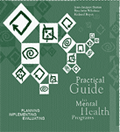Common menu bar links
Institutional links
Diseases & Conditions
Health & Safety
Research & Statistics
Agency Information
Search Box
E-mail this page
Mental Health Promotion
Mental Health Promotion
What's New
Mental Health - Coping with Stress - It's Your Health ![]()
First Connections... make all the difference
First Connections... make all the difference is a resource kit that has been developed to help professionals and parents promote secure infant attachment - a secure emotional connection with a main caregiver. A baby's earliest relationships and experiences of the world influence the course of development and help to shape emotions, relationships, thinking, learning, and behaviour throughout life. When attachment is secure, a baby feels safe, protected, and secure as she or he explores and learns about his or her expanding world.
A Report on Mental Illnesses in Canada
A Report on Mental Illnesses in Canada is designed to raise the profile of mental illness among government and non-government organizations, and the industry, education, workplace, and academic sectors. It describes major mental illnesses and outlines their incidence and prevalence, causation, impact, stigma, and prevention and treatment.
Coping with the Stress of Terrorism and Armed Conflict (9/11/02)
Terrorist attacks, acts of war, and sudden violent events such as disasters challenge our coping skills, even if we only witness them on television. If they touch our lives more closely (for example, if they occur near where we live, or affect people we know) they can cause a lot of distress, fear and anxiety. We worry about our own safety, the safety of our loved ones and our community.
The Practical Guide to Mental Health Programs

The Practical Guide is meant to support program directors throughout the decision-making process specific to program development and evaluation. It proposes a mode of operating to enable program directors and researchers to forge a satisfying and productive partnership. The first section of the Guide presents a frame of reference for program development and a decision-support tool (Program DST). This tool comprises a grid to be completed and an explanatory text for each item of the grid. The second section of the Guide proposes a frame of reference for program evaluation and another decision-support tool (Evaluation DST), which also consists of a grid and an explanatory text. Examples illustrate how to complete the grids. The Practical Guide may be used regardless of mental health problem, target population or level of program development.
